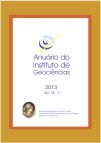Geoconservation of Trindade Island: Main Aspects and Potential Use
DOI:
https://doi.org/10.11137/2013_2_96_104Abstract
The Trindade Island is located near to the parallel of Vitória (ES), 1167 km from the Brazilian coast. It is considered as the most recent manifestation of alkaline volcanism of Brazil (<3.6 Ma). It represents the eastern end of an EW chain of guyots (Vitoria-Trindade) generated along a fracture zone associated to mantle plume activity beneath the South American plate. The island is composed by alkaline olivine-nephelinitic and phonolitic volcanic cycles, which evolves through fractional crystallization process. The lithostratigraphic units of the island (Trindade Complex, Desejado Sequence, Morro Vermelho Formation, Valado Formation and Vulcão do Paredão) show important volcanic structures, easily recognizable through the geomorphology of great landscape value. Structures like necks and radial dikes (eroded volcanic systems), vast plateaus formed by lava flows and/or pyroclastic deposits and even part of a large cinder cone, are among the structures observed in the island. Trindade justify its importance of geoconservation and maintenance its geosites beyond the use of its heritage in a sustainable manner due to the values: geological (petrological/petrogenetic and volcanological), geomorphological and historic (which refers to the time of the voyages of discovery). However, Trindade does not have potential for the development of geotourism or any activity comprising large numbers of people because it is distant and inaccessible. Its great value is scientific and didactic value, being an important field school for teaching, not only geology, but how different areas of the natural sciences.Downloads
Published
2013-01-01
Issue
Section
não definida
License
This journal is licensed under a Creative Commons — Attribution 4.0 International — CC BY 4.0, which permits use, distribution and reproduction in any medium, provided the original work is properly cited.
















 Except where otherwise noted, content on this site is licensed under a license
Except where otherwise noted, content on this site is licensed under a license 